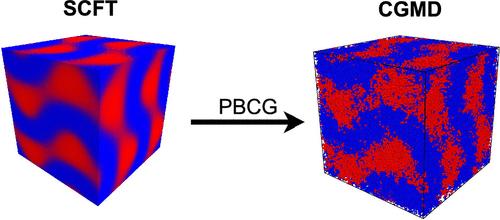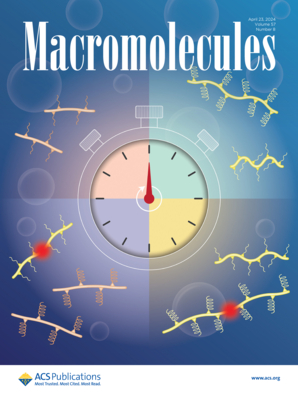传播者偏置链生成:精确反向映射微相分离嵌段聚合物
IF 5.1
1区 化学
Q1 POLYMER SCIENCE
引用次数: 0
摘要
我们介绍了传播者偏置链生成(PBCG)算法,该算法可为呈现微相分离的嵌段共聚物的粗粒度分子动力学模拟生成初始配置。我们以经典自洽场理论(SCFT)为基础,展示了如何正确利用其主要统计对象,即所谓的前向和后向链传播器,来偏置粗粒度珠链的配置。该算法得出的构型准确再现了 SCFT 预测的局部体积分数和空间段分布。PBCG 算法支持多尺度方法,允许模拟从非常接近相分离平衡的状态开始,而从随机初始状态开始通常很难获得相分离平衡。我们演示了如何将该算法应用于还原单元中的通用粗粒度系统,以及苯乙烯-异戊二烯-苯乙烯三嵌段共聚物等特定化学材料模型。本文章由计算机程序翻译,如有差异,请以英文原文为准。

Propagator-Biased Chain Generation: Accurately Reverse Mapping Microphase-Separated Block Copolymers
We introduce the Propagator-Biased Chain Generation (PBCG) algorithm, which generates initial configurations for coarse-grained molecular dynamics simulations of block copolymers presenting microphase separation. We build on the classical self-consistent field theory (SCFT) and show how its main statistical objects, the so-called forward and backward chain propagators, can be properly utilized to bias the configuration of coarse-grained bead–spring chains. Both the local volume fractions and the spatial segment distributions predicted by SCFT are accurately reproduced by configurations yielded by the algorithm. The PBCG algorithm supports the multiscale approach by allowing simulations to start in a state that is very close to the phase-separated equilibrium, typically much harder to obtain when starting from a random initial state. We demonstrate how to apply the algorithm to generic coarse-grained systems in reduced units as well as to chemically specific models of materials such as styrene-isoprene-styrene triblock copolymers.
求助全文
通过发布文献求助,成功后即可免费获取论文全文。
去求助
来源期刊

Macromolecules
工程技术-高分子科学
CiteScore
9.30
自引率
16.40%
发文量
942
审稿时长
2 months
期刊介绍:
Macromolecules publishes original, fundamental, and impactful research on all aspects of polymer science. Topics of interest include synthesis (e.g., controlled polymerizations, polymerization catalysis, post polymerization modification, new monomer structures and polymer architectures, and polymerization mechanisms/kinetics analysis); phase behavior, thermodynamics, dynamic, and ordering/disordering phenomena (e.g., self-assembly, gelation, crystallization, solution/melt/solid-state characteristics); structure and properties (e.g., mechanical and rheological properties, surface/interfacial characteristics, electronic and transport properties); new state of the art characterization (e.g., spectroscopy, scattering, microscopy, rheology), simulation (e.g., Monte Carlo, molecular dynamics, multi-scale/coarse-grained modeling), and theoretical methods. Renewable/sustainable polymers, polymer networks, responsive polymers, electro-, magneto- and opto-active macromolecules, inorganic polymers, charge-transporting polymers (ion-containing, semiconducting, and conducting), nanostructured polymers, and polymer composites are also of interest. Typical papers published in Macromolecules showcase important and innovative concepts, experimental methods/observations, and theoretical/computational approaches that demonstrate a fundamental advance in the understanding of polymers.
 求助内容:
求助内容: 应助结果提醒方式:
应助结果提醒方式:


